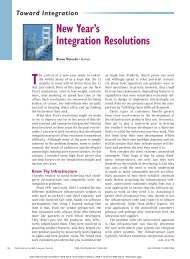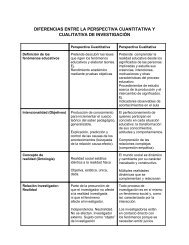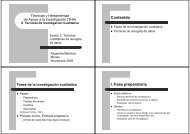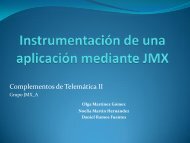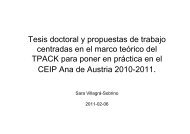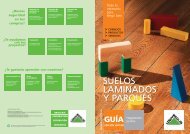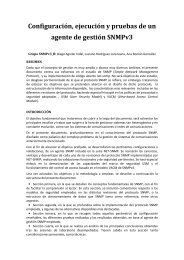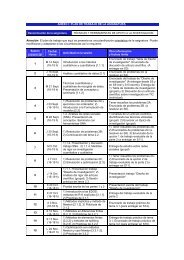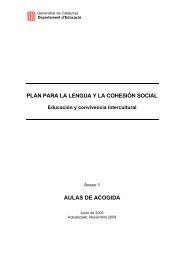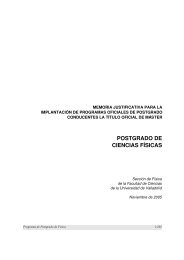Research Questions and Hypotheses
Research Questions and Hypotheses
Research Questions and Hypotheses
Create successful ePaper yourself
Turn your PDF publications into a flip-book with our unique Google optimized e-Paper software.
148 Designing <strong>Research</strong> Quantitative Methods 149<br />
logic of sampling theory (e.g., Babbie, 1990, 2007). Here are essential<br />
aspects of the population <strong>and</strong> sample to describe in a research plan:<br />
Identify the population in the study. Also state the size of this population,<br />
if size can be determined, <strong>and</strong> the means of identifying individuals<br />
in the population. <strong>Questions</strong> of access arise here, <strong>and</strong> the researcher might<br />
refer to availability of sampling frames—mail or published lists--of potential<br />
respondents in the population.<br />
Identify whether the sampling design for this population is single<br />
stage or multistage (called clustering). Cluster sampling is ideal when it is<br />
impossible or impractical to compile a list of the elements composing the<br />
population (Babbie, 2007). A single-stage sampling procedure is one in<br />
which the researcher has access to names in the population <strong>and</strong> can sample<br />
the people (or other elements) directly. In a multistage or clustering<br />
procedure, the researcher first identifies clusters (groups or organizations),<br />
obtains names of individuals within those clusters, <strong>and</strong> then samples<br />
within them.<br />
Identify the selection process for individuals. I recommend selecting<br />
a r<strong>and</strong>om sample, in which each individual in the population has an equal<br />
probability of being selected (a systematic or probabilistic sample). Less<br />
desirable is a nonprobability sample (or convenience sample), in which<br />
respondents are chosen based on their convenience <strong>and</strong> availability<br />
(Babbie, 1990). With r<strong>and</strong>omization, a representative sample from a population-provides<br />
i to generalize to a population.<br />
Identify whether the study will involve stratification of the population<br />
before selecting the sample. Stratification means that specific characteristics<br />
of individuals (e.g., both females <strong>and</strong> males) are represented in the<br />
sample <strong>and</strong> the sample reflects the true proportion in the population of<br />
individuals with certain characteristics (Fowler, 2002). When r<strong>and</strong>omly<br />
selecting people from a population, these characteristics may or may not<br />
be present in the sample in the same proportions as in the population;<br />
stratification ensures their representation. Also identify the characteristics<br />
used in stratifying the population (e.g., gender, income levels, education).<br />
Within each stratum, identify whether the sample contains individuals<br />
with the characteristic in the same proportion as the characteristic<br />
appears in the entire population (Babbie, 1990; Miller, 1991).<br />
Discuss the procedures for selecting the sample from available lists.<br />
The most rigorous method for selecting the sample is to choose individuals<br />
using a r<strong>and</strong>om numbers table, a table available in many introductory statistics<br />
texts (e.g., Gravetter & Wallnau, 2000).<br />
Indicate the number of people in the sample <strong>and</strong> the procedures used<br />
to compute this number. In survey research, I recommend that one use a<br />
sample size formula available in many survey texts (e.g., see Babbie, 1990;<br />
Fowler, 2002).<br />
instrumentation<br />
As part of rigorous data collection, the proposal developer also provides<br />
detailed information about the actual survey instrument to be used in the<br />
proposed study. Consider the following:<br />
Name the survey instrument used to collect data. Discuss whether it is<br />
an instrument designed for this research, a modified instrument, or an intact<br />
instrument developed by someone else.lf it is a modified instrument, indicate<br />
whether the developer has provided appropriate permission to use it. In some<br />
survey projects, the researcher assembles an instrument from components<br />
of several instruments. Again, permission to use any part of other instruments<br />
needs to be obtained. In addition, instruments are being increasingly<br />
designed for online surveys (see Sue & Ritter, 2007). An online survey tool is<br />
SurveyMonkey (SurveyMonkey.com ), a commercial product available since<br />
1999. Using this service, researchers can create their own surveys quickly<br />
using custom templates <strong>and</strong> post them on Web sites or e-mail them for participants<br />
to complete. SurveyMonkey then can generate results <strong>and</strong> report<br />
them back to the researcher as descriptive statistics or as graphed information.<br />
The results can be downloaded into a spreadsheet or a database for further<br />
analysis. The basic program is free for 100 responses per survey <strong>and</strong> no<br />
more than 10 questions per survey. For additional responses, more questions,<br />
or annual fee.<br />
To use an existing instrument, describe the established validity <strong>and</strong><br />
reliability of scores obtained from past use of the instrument. This means<br />
reporting efforts by authors to establish validity—whether one can draw<br />
meaningful <strong>and</strong> useful inferences from scores on the instruments. The<br />
three traditional forms of validity to look for are content validity (do the<br />
items measure the content they were intended to measure?), predictive or<br />
concurrent validity (do scores predict a criterion measure? Do results correlate<br />
with other results?), <strong>and</strong> construct validity (do items measure hypothetical<br />
constructs or concepts?). In more recent studies, construct validity<br />
has also included whether the scores serve a useful purpose <strong>and</strong> have positive<br />
consequences when they are used in practice (Humbley & Zumbo,<br />
1996). Establishing the validity of the scores in a survey helps to identify<br />
whether an instrument might be a good one to use in survey research. This<br />
form of validity is different than identifying the threats to validity in experimental<br />
research, as discussed later in this chapter.<br />
Also discuss whether scores resulting from past use of the instrument<br />
demonstrate reliability. Look for whether authors report measures of internal<br />
consistency (are the items' responses consistent across constructs?)



